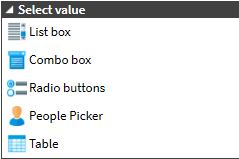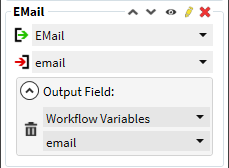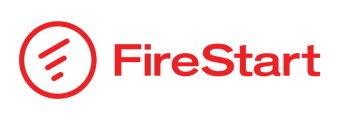There are five controls for task forms that can be used to select data.

And with the exception of the People Picker, every one of them can be configured exactly the same.
Note: In the background, the People Picker configuration works with the same data structure but from a UI standpoint, the configuration looks different and is a light version of what can be configured for the other controls.
The data bound to a selection control is always something represented by a table:
- a business entity where the selected items are the rows of the table, and the fields are its columns or
- a table with custom defined values by the user
Note: Even the data for a Combo box control or for Radio buttons control is a table that can have 1 to n columns. Most of the time only one of these columns will be set visible for this kind of controls though.
Configuration
When you drag a new selection control into the form in the form builder, you get a configuration in the property panel that looks like this:

There are three dropdown boxes and a button
- Selection
Lets you choose, if you want the control to be read-only or read/write (and for tables, choose between read-only, Single or Multi select). - Source
Lets you choose if you want the source data to come from custom defined values or one of the business entities referenced by the task - Target
Lets you choose if you only want to write cell values of the selected entries or if you want to select\create the items of a business entity referenced by the task- only write cell values
for every column you add to your control you can define an output field where the selected cell values of that column will be written to in case multiple records are selected the values of the selected cells will be joined by a semicolon and written as a single string to the output field - select items
if the target business entity is of the same business entity operation as the source business entity and has the same LinkUsage (Live/Test), the items the user selects in the form will be selected by their ForeignItemId in the target business entity - create items
if the target business entity is set to Create new and is different from the source business entity, the items the user selects will be newly created in the target business entity
- only write cell values
- Add column
With the button Add column, you have to add columns of the underlying data table to further configure where this data should come from or should be written to
Column settings
Depending on the combination of Source and Target settings, the column configuration interface has a smaller or larger set of configuration possibilities.
When Source and Target are both business entities but are different, you get the largest set of things to configure:

There are a number of options:
- You see the name of the column, it can be freely edited and is only relevant for table controls where it is displayed as the header of a column
- On the top right you can see a number of buttons
- move the column order up or down
- show/hide the column in the form for the user (hidden columns can still be written in the workflow)
- edit the column name
- remove the column
- If there is a Source business entity, you have to choose the field that is mapped to the column
- If there is a Target business entity that is different from the Source, you have to choose the field the column is mapped to
- If you want to optionally write the value(s) of the selected cell(s) you can define an output field by setting a business entity link. The values of all user selected rows of this column will be written to this output field joined by a semicolon
Note: Controls like Combo box, Radio buttons or List box join the values of every visible column with a space " " and show this string as a display value!
